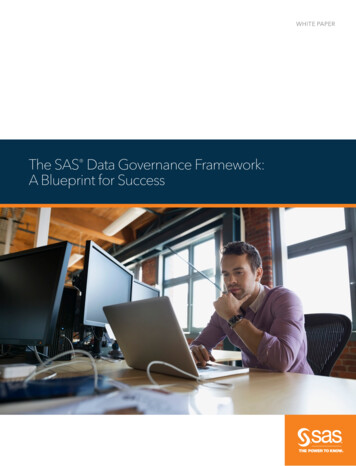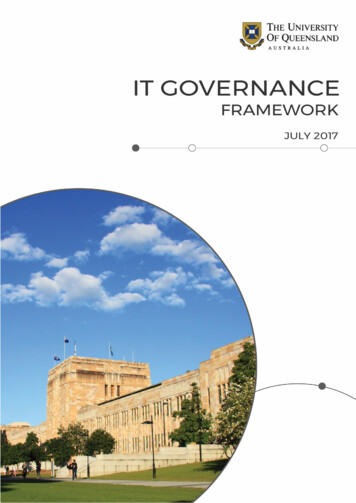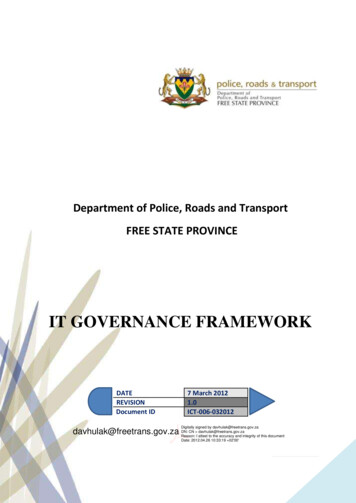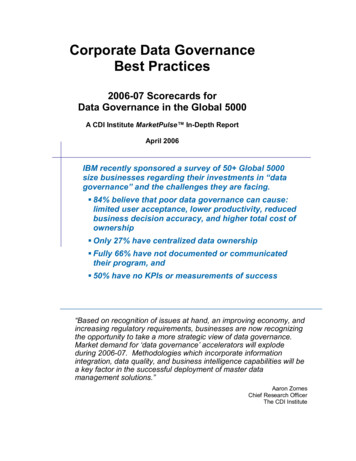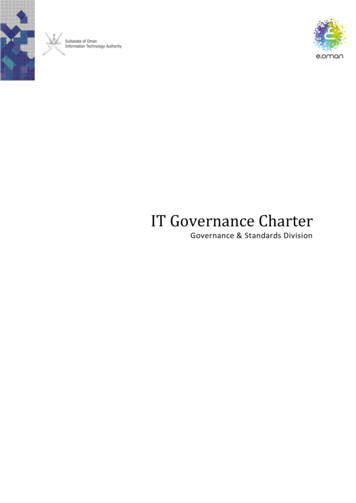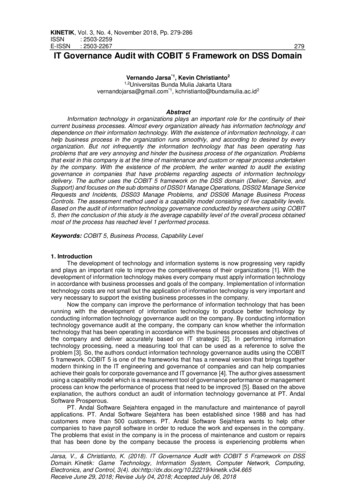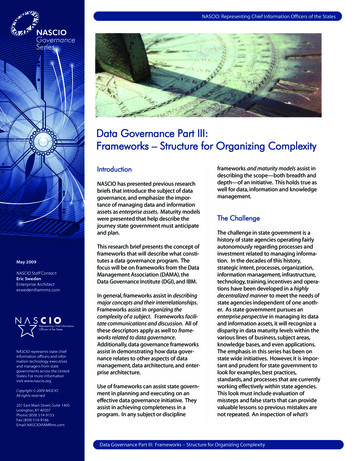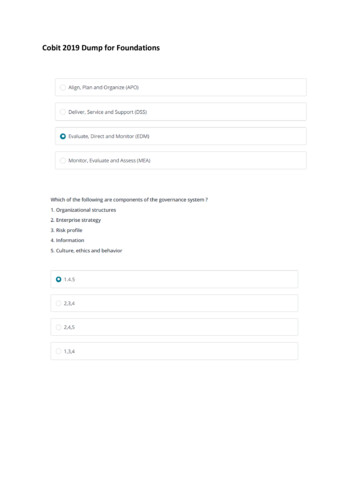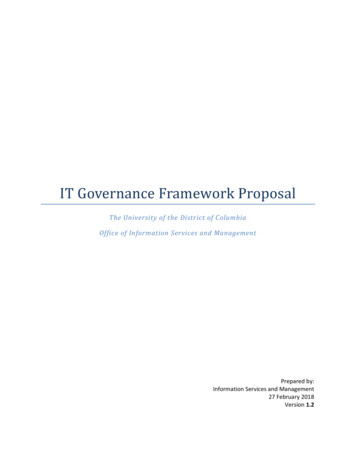
Transcription
IT Governance Framework ProposalThe University of the District of ColumbiaOffice of Information Services and ManagementPrepared by:Information Services and Management27 February 2018Version 1.2
Table of ContentsRevision History . 3I.Executive Summary . 4Objectives . 5II.Framework Model . 6Principles .10III.Organizational Structure .11IV.Process Flow .11V.Membership.13Proxy in Absence .13VI.Governance Ownership .13VII.Bibliography .14Appendix A: .15Page 2Ver. 1.02
Revision HistoryVersionDateAuthorComments0.10.214 Jan 1615 Jan 16Michael RogersMichael Rogers / TroyStovallInitial DraftUpdated content /Response to Troy’scomments. Acceptedcorrections in SummaryGrammatical changesand minor formattingchanges. AddedAppendix A0.31 Feb 16Michael Rogers / TroyStovall0.43 Feb 16Michael RogersMinor bibliographyedits. AddedCommittee roles andresponsibilities0.52 Mar 16Michael RogersUpdated content:Subcommittees, proxyvoting, organization,member list1.04 Mar 16Michael RogersFinal1.125 Oct 16Michael Rogers1.216 Feb 18Brandon RussellUpdated personnel list;updated departmentnameMinor updatesPage 3Ver. 1.02
I.Executive SummaryIn today’s economic landscape Universities are consistently facing cost cutting measures and virtually allspending is being scrutinized by every level of University leadership. Each dollar invested must be doneso with the knowledge that the outcome of the expenditure must play a role in helping the Universitymove closer toward the realization of its strategic vision. Because of this need to improve the efficiencyof University operations, no longer can departments and colleges establish silos which operateindependent of the rest of the University. Collaboration, cooperation and the efficient use of sharedservices are the new operational paradigms in higher education. To facilitate this, organizations areworking to define clear, precise, and repeatable operations within their business units, particularlyinformation technology. Since 2010 every Big Ten University as well as countless others across thenation has engaged in the process of establishing or reviewing their governance models. The creation ofan effective governance model will ensure that the University is working towards their goals andobjectives. To this end, as it relates to Information Technology, IT Governance is regarded as the singlemost important factor in generating value from IT, and is inherently critical to the success of everyinstitution.The need to improve the value proposition of each department is paramount; as such, Universitiesacross the nation are eliminating distributed operational models in favor of more centralized structures,particularly in areas where common services are used throughout the entire institution. Every unitleader or department head must clearly demonstrate how their budget resources are being utilized tohelp achieve long term and wide spread objectives which contribute to the success of various corefunctions across the enterprise. In the case of information technology the method by which this isachieved is through the development and implementation of a comprehensive governance framework.At UDC governance will help to accomplish three primary goals; the first is to provide clear guidance onhow decisions regarding technology and projects are made. With a standard methodology to weighoptions and make informed choices about how technology can best support the University enterprise,this proposed governance framework will help ensure that IT choices are closely aligned with thestrategic objectives of the University. Second, through careful and thoughtful decision making, UDCslimited pool of shared IT resources can be judiciously distributed across the user community, based onneed and priority, ensuring that preferential treatment and operational bias do not exist. Finally, thedeployment of an IT governance framework will provide transparency into the decision making processat UDC. This transparency will allow users across all areas to become active participants in executing theUniversity’s priorities. Active and participating membership will be the hallmark for engaging thestudents, faculty and staff in the success of the proposed governance model and will allow each user tobecome an active participant in the decisions that will define our future IT infrastructure.Because spending must not be done in a vacuum and should be coordinated with ongoing initiativesacross the institution, the IT Governance Committee must effectively reach out to all business units andcolleges to ensure each voice and opinion is heard. The cross departmental approach will result inimproved efficiencies by verifying that each dollar invested in IT will work in concert with the spendingplans of every department, University wide. This coordination will help to eliminate duplicativePage 4Ver. 1.02
information technology measures including staffing levels as well as computing resources such asapplications, hardware, and storage.ObjectivesThis proposal seeks to establish an IT governance model which will improve consistency in how ITdecisions are made while fostering an improved level of collaboration, communication, andtransparency. The proposed framework shall promote an increased level of efficiency as well asoperational effectiveness, desperately needed at UDC. Like most operational methodologies, thisstructure is expected to change over time as the process approach becomes more mature; therefore thebasic structure of the governance body and the approach they use to make decisions must remain agile.It is noteworthy to mention that this framework will focus strictly on decision making and prioritizationof projects and will not impose direction on the Office of Information Services and Managementregarding the implementation process.The COBIT and VAL IT framework states that the “purpose of IT governance is to direct IT endeavors, toensure that It’s performance meets the following objectives:1.2.3.4.Alignment of IT with the enterprise and realization of the promised benefitUse of IT to enable the enterprise by exploiting opportunities and maximizing benefitsResponsible use of IT resourcesAppropriate management of IT-related risks” (IT Governance Institute, p. 3)Given the current financial status of UDC and the fiscal environment which we face, competing prioritiesacross the University must be adequately prioritized to leverage the limited IT resources available toservice business needs.Currently most users in the UDC system have no insight into the overall operations of the Office ofInformation Services and Management. Most users see ISM as an on demand service which primarilyconsists of a Customer Service Desk and a Project Management Office which executes the on demandinstallation of hardware and software throughout the campus. Often times ISM is excluded from thevarious planning stages of project development and is then provided with unrealistic milestone dateswhich constrain their technical ability to offer integrated solutions that can provide cost savingefficiencies such as software licensing or hardware acquisition to the University. The proposedoperational framework hopes to positively impact this paradigm by achieving the following:1. Providing transparency into the decision making process for project prioritization2. Involve ISM in the earliest phases of project development3. The establishment of a common set of project artifacts which define the scope, scale andmilestones for all projects which require the use of ISM resources4. Capacity planning for the reasonable establishment of project delivery milestones based on thecapacity of ISM resources, to include (but not necessarily limited to) server capacity, storagecapacity, network bandwidth and availability, and human capital capacityPage 5Ver. 1.02
II.Framework ModelThe IT Governance Reference Model: The starting pointThe core tenets of IT governance can be abstracted into a multistrata reference model (figure 1) asdemonstrated below:Note that the layers of the model split broadly into the following categories: Internal environment—it is essential to establish a cultural and operating climate that isconducive to, and promotes, effective IT governance. Culture consists of exhibiting leadershipand is represented in value statements, mission statements and guiding principles. Valuestatements are the core beliefs and philosophies that shape the organization’s vision andmission. Guiding principles are durable statements that encapsulate the role ISM will play andhow decisions will be driven in both the business and ISM organizations, and at each abstractionlevel of the enterprise, i.e., strategic, tactical or operational. Guiding principles are enacted bycontrols in the form of policies, standards and procedures.Entrustment framework—central to IT governance is the notion of accountability and authority.An accountability framework ensures clarity of, and accountability for, desired outcomes andshould be defined with clear assignment of roles and responsibilities. Decision authorities areindividuals or bodies, e.g., committees and boards that are empowered to make and ratifyPage 6Ver. 1.02
decisions regarding the use of ISM resources. The framework should also include organizationalstructures, constructs, and functional interrelationships.Decision model and framework—a common decision framework enables prudent, sound andinformed decision making. It involves the clear assignment of decision rights and definessequences of actions and decision paths in the decision processes. The goal should be to makedecisions based on a more manageable set of possibilities by eliminating choices that are inconflict or inconsistent with the guiding principles and policies. A decision-making model helpsensure that IT decisions are coherent and consistent with the University direction and alignedwith the overall institutional strategies. Decision factors need to be defined that weigh theimportance of trade-off decisions. These factors might include cost-benefit analysis, riskidentification, scope definition, and financial impact, time to delivery, and efficiency andeffectiveness of delivery. The design of the model should be geared to the number and type ofdecisions that need to be rendered.Value management—this aspect of IT governance is concerned with the delivery of businessvalue from IT investments. The objective of value management is to ensure that organizationsmaximize value by optimizing the benefits of investments throughout their economic life cyclewithin defined risk tolerance thresholds. IT value management involves the continuousawareness of value for the University, establishing measures or estimates of value thenmonitoring and controlling them.Value realization and delivery framework—value realization has two dimensions, demandmanagement and supply management.Demand management includes the activities involved with generating demand for the productsand services offered by the University. This translates into the need to ensure the overallstrategy and IT strategy align and that the University demonstrates effective portfoliomanagement and prudent investment management.Supply management consists of the activities that are directly involved with provisioning andsupplying the products and services offered by the institution.The IT Governance Institute (ITGI) has distilled value demand and delivery into five core disciplines.These focus areas, as depicted in figure 2, are: create value (through strategic alignment), deliver value,risk management, resource management and performance measurement.Page 7Ver. 1.02
IT governance encompasses the decision framework, rights, responsibilities and accountability to ensuredesired behavior in support of the University’s business goals.The IT Governance Reference Model: Proposed FrameworksSpecifically IT governance comprises a set of formal and informal rules and practices that determinehow empowerment is exercised, how IT decisions are made and how IT decision makers are heldaccountable for serving the institutional interest.Establishing an IT governance program can be characterized as a blend of systematic process analysiscoupled with aspects of behavioral science. Unlike projects of limited scale or those localized to aspecific University function, IT governance permeates the organization at all levels of management andacross functional boundaries. Every institution has a unique personality that reflects their culturalecosystem and operating style. For this reason, implementing IT governance does not follow a one-sizefits-all mold. For IT governance to be effective, it needs to reflect the prevailing culture and beinterwoven into the operational fabric of the organization.As advised by many, it is likely too early in the governance process to stick too closely with a specificplatforms as it deflects from approaching governance in a more holistic manner however, while subjectPage 8Ver. 1.02
to change as the operational component of UDC’s governance model matures, this proposal ispredicated on the implementation of a hybrid model of two (2) separate and complimentary frameworkstructures:1. COBIT 52. Val IT 2.0COBIT 5 provides five high-level principles that are essential for the effective management andgovernance of enterprise IT:1.2.3.4.5.Principle 1: Meeting Stakeholder NeedsPrinciple 2: Covering the Enterprise End-to-EndPrinciple 3: Applying a Single Integrated FrameworkPrinciple 4: Enabling a Holistic ApproachPrinciple 5: Separating Governance from ManagementThese five principles enable an organization to build a holistic framework for the governance andmanagement of IT that is built on seven enablers’. The enablers are:1.2.3.4.5.6.7.People, Policies and FrameworksProcessesOrganizational StructuresCulture, Ethics and BehaviorInformationServices, Infrastructure and ApplicationsPeople, Skills and CompetenciesTogether, the principles and enablers allow an institution to align its IT investments with its objectives torealize the value of those investments.Val IT is layered on top of COBIT 5 and is focused as an enterprise governance solution which will helpthe ISM department and UDC, as a whole, develop a common language and operational best practiceswithin the COBIT framework.Tailoring the Style of IT Governance to Mesh with the University EnvironmentThe implementation of IT governance, even when the leading practice frameworks are adopted, istypically challenging given its somewhat amorphous form. The unique nature of every organizationmeans that cultivating an environment conducive to desirable behavior in the use of technology willvary from organization to organization. In spite of the obstacles, gaining an understanding of threeinfluencing factors will provide reasonable assurance that the deployed IT governance practices andprocesses are aligned with the cultural and operational nuances of the University.Page 9Ver. 1.02
Three primary influencing factors within an organization’s profile are:1. The business model—articulates how the organization will create and sustain value for itscustomer(s)2. The operational mode—defines the role ISM performs in providing value to the organization3. The personality profile—the manner in which an institution characterizes itself. It is theUniversity’s identity and unique characteristics.Another important consideration when customizing IT governance is the change driver. This is thecatalyst, event or proposition that provides the impetus to focus on IT governance. Change driverssurface in many forms but are typically rooted in three themes: the need for operational excellence, riskmanagement, and regulatory compliance. The desire to achieve operational excellence is driven by thegoal of deriving optimal business value from ISM assets by emphasizing efficiency and effectiveness. Forexample, value can be realized by pursuing a shared services strategy, by defining a service-orientedarchitecture (SOA) or by establishing an enterprise technical architecture. By contrast, if the driver’ssource is risk management or regulatory compliance, it is typically a response to external requirementssuch as the introduction of a new law or regulatory mandate.PrinciplesThere shall only be one IT Governance Board for both academic as well as administrative processes1. The President shall sanction and endorse the establishment of an IT governance board to ensureISMs success and effectiveness2. The governance board must represent a cross section of all University areas and shall address allprojects and matters which affect the University systems3. Aggregate funding across academic and business units may be required to realize objectives andefficiencies as defined by the governance boardIn order to be vetted and prioritized by the governance board, technology related requests should meetone or more of the following criteria:1. The proposed project requires a minimum of 10 hours of dedicated ISM support which mayinclude planning and design considerations2. It impacts the University in a significant manner through a directional, policy, service, systems,security, financial processing, interface, operational or strategic perspective3. It integrates with one or more existing systems (this includes the deployment of additionalmodules or interfaces for existing systems)The following circumstances are exceptions to the aforementioned criteria:1. Patching and upgrades of the existing systems are a function of the ongoing operations andmaintenance (O & M) of the University and do not require governance board approval2. ISM initiatives which are a part of a capital project must be disclosed and adequately accountedfor by the governance board, but do not require additional approvalsPage 10Ver. 1.02
The transparency of the governance board is of paramount importance to the success of itsestablishment and ongoing operation, to this end the board must assign a secretary to record notesand/or meeting minutes. These minutes must be published in a reasonable timeframe following eachboard meeting in a publically accessible location such as the IT Governance webpage. Furthermore, eachmeeting of the governance board must be announced in advance to allow interested parties sufficienttime to have items reviewed/discussed during the meeting.All governance board meetings must be open to all members of the University community, should theywish to attend.Proposals to the board should be required to meet a standard format with predetermined pieces ofinformation available. These should include (but not be limited to) estimated cost, estimated level ofeffort, associated risk, impact, correlation to the strategic goals of the University.III.Organizational StructureThe proposed structure of the IT Governance Committee will consist of three separate sub-committeesor working groups. Each sub-committee will be focused on reviewing and championing project proposalswhich fall within their specific areas of operation. The proposed sub-committees are: OperationsAcademic TechnologyStudent ServicesSub-committees will be charged with the responsibility of assisting a project stakeholder in thedevelopment of a detailed blueprint for all projects which have been approved for further investigationby the committee as a whole. Sub-committees will be expected to appoint an acting chairperson and willmeet as needed to address project proposals submitted to them by the Executive Director. All projectswill be expected to follow a standard format for blueprint submissions and the sub-committee willensure each submission meets this standard.IV.Process FlowThe following steps outline the process by which requests and proposals enter into, and travel throughthe IT governance framework.1. Requests from the University community for technology-related improvements are injected intothe IT governance process by submitting a brief project overview form to the Office ofInformation Services and Management.The project overview form will be a standard document and must include the following: Project NameStakeholder Name and DepartmentPage 11Ver. 1.02
Estimated Project CostEstimated Level of EffortRequested Delivery TimelineBrief description of the Project and its benefits to the UniversityISM, which serves as a single point of contact, acts as a clearinghouse to ensure that requestsflow through the governance process from start to finish. ISM also ensures that the requestmeets the criteria delineated in this proposal and that the same request is not being submittedby multiple parties. ISM tracks requests and ensures that all required information is codified inthe proper format. All project requests must be submitted no later than 2 weeks prior to themonthly governance meeting to be considered for voting. Any project requests submittedafter the 2 weeks will be presented at the following month’s governance meeting. This is toallow ISM sufficient time to review the project, gather requirements, and provide estimatedtimelines to the committee.2. ISM submits the completed proposal to the members of the governance board.3. The governance board distributes copies of the proposal to technical, security, risk, liability,legal, ethical, regulatory, policy, procedural, and other accountability reviewers. These reviewersare asked only to consider potential risks and issues with the proposal. Their comments willbecome part of the proposal as it moves forward through the process.4. Each of the reviewers submits a form to the governance board indicating whether there are anyissues or concerns with the proposal. As noted above, concerns may be related to IT security,capacity, support, or legal/regulatory issues.5. The IT governance board considers proposals and decides which ones to recommend for action.Each recommended project proposal is submitted to the appropriate sub-committee for followup action.6. Sub-committees work with project stakeholders to develop a detailed blueprint which includes athorough estimate of cost, level of effort, functional requirements, risk analysis, cost benefitanalysis and delivery recommendation date.Advisory members of the governance committee are expected to work with each subcommittee as needed to ensure technical, regulatory and risk base factors have been consideredin the final project blueprint.7. In the event of new product implementations or wide scale product modifications, projectblueprints are submitted to ISM where functional analysis will be performed against thebusiness defined requirements. This requirement analysis will be used to evaluate the marketand determine the best product to meet the business needs. Project blueprints will be updatedwith technical recommendations and submitted back to the appropriate sub-committee.8. Sub-committees will distribute the project blueprint to all committee members for review andanalysis.Page 12Ver. 1.02
9. The IT governance board considers proposed project blueprints and decides which ones torecommend for action. The board ranks those projects based on specified criteria, includingimpact, importance, risk, and funding models.10. The governance board formally submits the rank ordered list of proposals to the ExecutiveDirector of ISM for implementation planning.11. The Executive Director of ISM becomes responsible for the implementation of the submittedprojects and communicates scheduling and timelines to the submitter. Once agreed upon, theExecutive Director communicates these decisions to the governance board and the decisions arepublished in the minutes for transparency.12. Technical project teams are formed according to the proposed schedule and monthly reportingof budgets and milestone are presented to the governance board by the Executive Director.V.MembershipThe Executive Director of ISM shall serve on the IT governance board as the board chair. Legal counseland the Budget Director should also serve on the Council in an ex officio capacity. The remainder of theIT governance board shall be made up of business unit heads, academic Deans and representatives fromthe faculty senate. This board should meet monthly to assess the ongoing requests for technologyrelated projects needed at the University.A proposed list of initial committee members is detailed in Appendix A.Proxy in AbsenceShould a committee member be unavailable to attend any session of the IT governance board they may,with prior notice, send a proxy representative. The proxy member must have a thorough understandingof the operation, function and processes of the governance committee, ensuring there is no need tobring the proxy member “up to speed” during the meeting.Any vote cast by a proxy member will be considered a valid and accurate representation of the memberin absence and may not be reversed after the fact.VI.Governance OwnershipIt is recommended that the owner of the IT governance is the Executive Director of Information Servicesand Management. Furthermore it is recommended that, as the process owner, he chairs the governanceboard and is the individual who makes the final decision regarding how proposals shall be implemented.As a University, we should use governance as an opportunity to change cultural aspects that lead toinstitutional improvement. The role of the Executive Director of ISM in this governance process must beclear and well defined. Otherwise, governance becomes a question of who is responsible for makingtechnological decisions regarding the University’s strategic plan.Page 13Ver. 1.02
VII. BibliographyWeill, Peter and Ross, Jeanne W. “Preface and Acknowledgements.” IT Governance: How TopPerformers Manage IT Decision Rights for Superior Results. Boston: Harvard Business School, 2004. PrintIT Governance Using COBIT and Val IT: Student Book. 2nd ed. N.p.: IT Governance, 2007. IT GovernanceInstitute. WebWallace and Webber, IT Governance: Policies & Procedures. 2013 Ed. New York: Wolters Kluwer Lawand Business, 2013. PrintPage 14Ver. 1.02
Appendix A:The UDC IT governance committee shall be composed of three separate positions of responsibility.These positions are: OversightKey PlayerAdvisoryEach position offers a specific function to the committee, overall.The Oversight role provides assurances that the committee is acting on the best interest of theUniversity and in compliance with legal and regulatory requirements.The Advisory role is primarily technical, but in all instances these individuals provide subject matterexpertise to assist the committee in making project decisions. These members may be called upon toprovide estimated levels of effort, feasibility analyses, or impact assessments for various projectsproposed to the committee.The Key Player is the voting member of the committee. Each has equally weighted voting rights andserves to empower the committee to make priority related decisions for ISM projects across theUniversity.Page 15Ver. 1.02
Proposed governance committee members:Advisory membersStakeholder NameRonald MasonShaina CooperDavid FranklinKaren HardwickAlfred CavanaughKrishna SaraiyaStakeholder RolePresidentCFODeputy Chief Operating OfficerGeneral CouncilISM - ComplianceInternal tOversightOversightVoting Members:Stakeholder NameDr. William LathamPatricia JohnsonErik ThompsonDwight SanchezBrandon RussellLeslie PinyanAloysius RegisShawn McCannTroy StovallDr. Tony SummersDr. April MasseyDr. Sabine O'HaraDr. Devdas ShettyDr. Mohamad SepehriShelley BroderickDr. Tony JohnsonDr. Marilyn HamiltonDr. Hermina PetersMaria ByrdMike RogersArlene King-BerryStakeholder RoleChief - SDSVP – Talent ManagementVP - CARESAVP - Enrollment ManagementISM - EngineeringISM - ApplicationsISM - TelecommunicationISM - Software DevelopmentChief Operating OfficerChief Community College OfficerDean- CASDean - CAUSESDean - SEASDean - SBPADean - Law SchoolDean – WWDLDean – Academic AffairsDean – Student AchievementOPIE – Executive DirectorISM – Executive DirectorFaculty soryAdvisoryAdvisoryAdvisoryKey PlayerKey PlayerKey PlayerKey PlayerKey PlayerKey PlayerKey PlayerKey PlayerKey PlayerKey PlayerKey PlayerKey PlayerKey PlayerPage 16Ver. 1.02
decisions regarding the use of ISM resources. The framework should also include organizational structures, constructs, and functional interrelationships. Decision model and framework—a common decision framework enables prudent, sound and informed decision making. It involves the clear assignment of decision rights and defines
